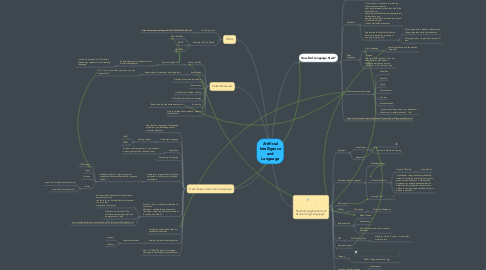
1. Other
1.1. The Turing Test
1.1.1. https://www.aaai.org/Papers/AAAI/1994/AAAI94-003.pdf
1.2. Examples of AI in Media
1.2.1. Deus Machina
1.2.2. Wall-E
1.2.3. HAL 9000
2. How does an AI Learn Langauge
2.1. Using human experience of language acquisition and translating that to computer language
2.2. Computer Language
2.2.1. Coding scripts
2.2.1.1. JAVA
2.2.1.2. HTML
2.3. Algorithms
2.3.1. Pattern-matching systems – only capable of recognising what it already know
2.4. Processing Computers
2.5. navigators – programme that allows computer to follow simple, spoken commands
2.5.1. dictation systems – large recognition capability; creates written text from speech quickly
2.5.1.1. OK Google
2.5.1.2. Alexa
2.5.1.3. Cortana
2.5.1.4. Issues
2.5.1.4.1. need to be trained for user’s voice
2.5.1.4.2. not ideal for multiple users
2.6. Parsers – aim to replicate production of sentences Method – working through sentence (left-right), trying to predict next element based upon patterns
2.6.1. An Information Condition: All information necessary to carry out the task can be identified and acquired in a form that computers can process.
2.6.2. A Processing Condition: The information processing itself can be expressed in rules.
2.6.3. http://content.thirdway.org/publications/714/Dancing-With-Robots.pdf
2.7. simplifying complicated tasks into condensed structures
2.8. Speech synthesis and recognition
2.8.1. regional variations
2.8.1.1. accents
2.8.1.2. dialects
2.9. Yule, G. (1996) The study of language. Cambridge: Cambridge University Press.
3. Potential Issues
3.1. Uncanny Valley
3.1.1. Fear of AI takeover
3.1.1.1. Should there be an imposed limit to artificial intelligence?
3.1.1.1.1. Is there an imposed limit? Is there a threshold in regards to an AI learning language?
3.2. Inaccuracies
3.2.1. Responding to questions with a question
3.2.1.1. E.G "I'm not sure what you mean, can you repeat that?"
3.3. Abusing user-aided algorithms
3.4. Automation
3.5. Unstructured Problem Solving
3.6. Difficulty with situational contexts
3.7. Solved by
3.7.1. Better models with understanding of
3.8. Only replicates human speech, doesn't understand it
4. How Did Language Start?
4.1. Positive and Negative Reinforcement
4.2. Early Man
4.2.1. "Information is encoded, sent along a communication channel, and then decoded at the other end. If the algorithms for encoding and decoding are appropriately calibrated to one another, then what is encoded at one end is identical to what is decoded at the other end."
4.2.2. Speculation that hominids (human ancestors) started by grunting or hooting or crying out
4.2.2.1. AI can begin with a better understanding of language than early homo-sapiens
4.2.2.2. Only speculation - impossible to know for sure
4.3. Body Language
4.3.1. Sign Language
4.3.1.1. Teaching children and the hearing impaired
4.3.2. "signals are used “intentionally”—a notion that contrasts with signals that are produced in a more “reflexive” or “automatic” way."
4.4. Development of Language
4.4.1. Grammar
4.4.2. Spelling
4.4.3. Mode
4.4.4. Pronunciation
4.4.5. Context
4.4.6. Standardisation
4.4.7. “having something to say is an attribute of the human’s mental processes" Yule
4.5. https://ase.tufts.edu/cogstud/jackendoff/papers/howdidlanguagebegin.pdf
5. Practical Applications of AI Learning Language
5.1. Hospitals
5.1.1. Care Homes
5.1.1.1. Artificial Friendships
5.1.1.2. 'At Home' Health monitoring
5.1.2. Hospices
5.2. Teaching Other Languages
5.2.1. Multilingualism
5.2.2. Online Translators
5.2.2.1. Google Translate
5.2.2.1.1. Inaccuracies
5.2.2.2. "translations using statistical probability instead of complex rules based on syntax, grammar and semantics. They directed computers to analyse translated texts to determine the probability that a word or phrase in one language matched a word or phrase in another"
5.2.3. Learning Tool
5.2.3.1. C
5.3. Classrooms
5.4. Military
5.4.1. Espionage
5.4.1.1. Decoded Messages
5.5. Entertainment
5.5.1. Video Games
5.5.2. Screenplays
5.5.3. Fear of Automation even in creative indrusties
5.6. GPS
5.6.1. Self Driving Cars
5.6.1.1. Need to inform "drivers" of road signs, warnings ect.
5.7. Companionship
5.8. Therapy
5.8.1. PARO Therapeutic Robot
5.9. Teaching other languages
5.9.1. Multilnguism
5.9.2. Google Translate
